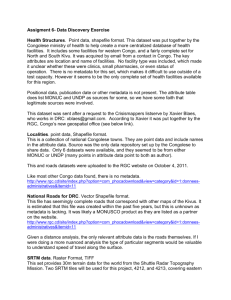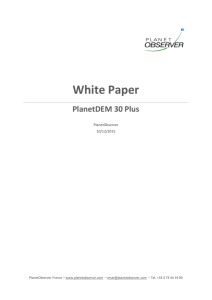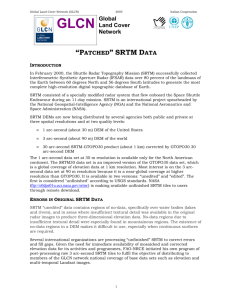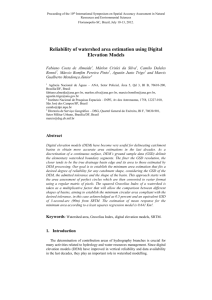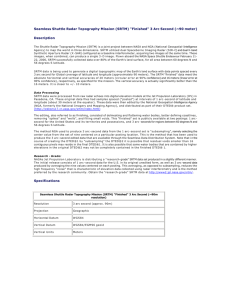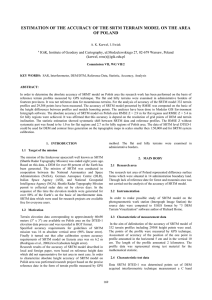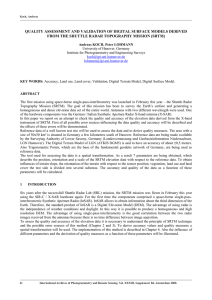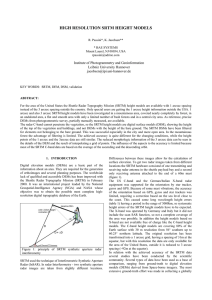SRTM DATA CHARACTERIZATION IN URBAN AREAS
advertisement
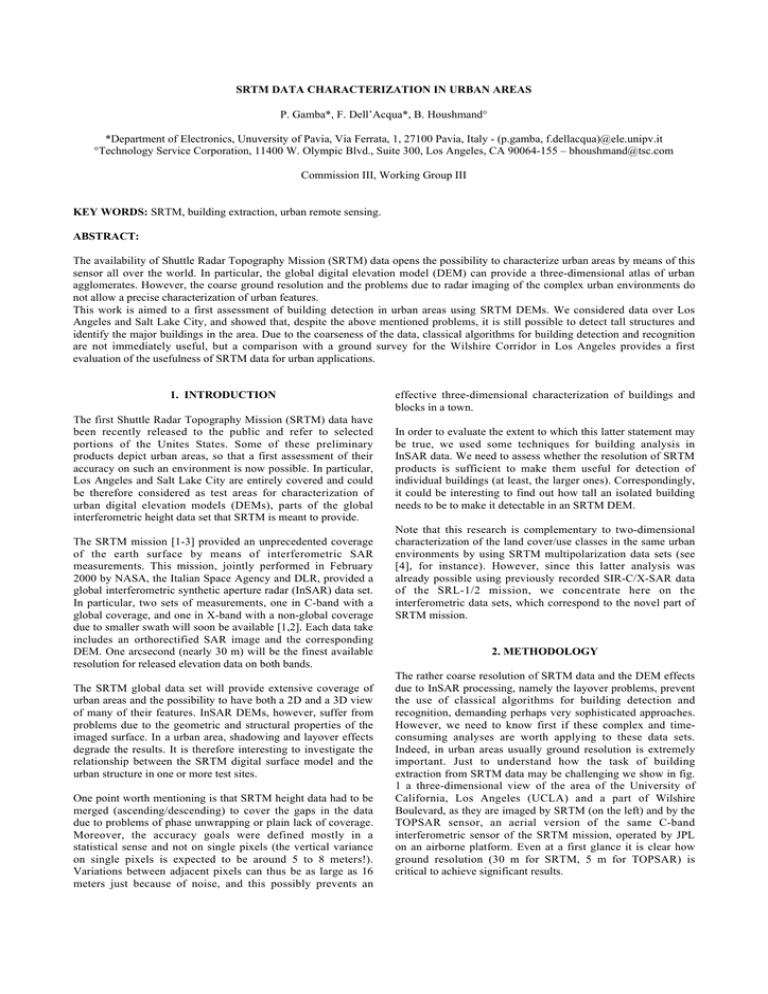
SRTM DATA CHARACTERIZATION IN URBAN AREAS P. Gamba*, F. Dell’Acqua*, B. Houshmand° *Department of Electronics, Unuversity of Pavia, Via Ferrata, 1, 27100 Pavia, Italy - (p.gamba, f.dellacqua)@ele.unipv.it °Technology Service Corporation, 11400 W. Olympic Blvd., Suite 300, Los Angeles, CA 90064-155 – bhoushmand@tsc.com Commission III, Working Group III KEY WORDS: SRTM, building extraction, urban remote sensing. ABSTRACT: The availability of Shuttle Radar Topography Mission (SRTM) data opens the possibility to characterize urban areas by means of this sensor all over the world. In particular, the global digital elevation model (DEM) can provide a three-dimensional atlas of urban agglomerates. However, the coarse ground resolution and the problems due to radar imaging of the complex urban environments do not allow a precise characterization of urban features. This work is aimed to a first assessment of building detection in urban areas using SRTM DEMs. We considered data over Los Angeles and Salt Lake City, and showed that, despite the above mentioned problems, it is still possible to detect tall structures and identify the major buildings in the area. Due to the coarseness of the data, classical algorithms for building detection and recognition are not immediately useful, but a comparison with a ground survey for the Wilshire Corridor in Los Angeles provides a first evaluation of the usefulness of SRTM data for urban applications. 1. INTRODUCTION effective three-dimensional characterization of buildings and blocks in a town. The first Shuttle Radar Topography Mission (SRTM) data have been recently released to the public and refer to selected portions of the Unites States. Some of these preliminary products depict urban areas, so that a first assessment of their accuracy on such an environment is now possible. In particular, Los Angeles and Salt Lake City are entirely covered and could be therefore considered as test areas for characterization of urban digital elevation models (DEMs), parts of the global interferometric height data set that SRTM is meant to provide. In order to evaluate the extent to which this latter statement may be true, we used some techniques for building analysis in InSAR data. We need to assess whether the resolution of SRTM products is sufficient to make them useful for detection of individual buildings (at least, the larger ones). Correspondingly, it could be interesting to find out how tall an isolated building needs to be to make it detectable in an SRTM DEM. The SRTM mission [1-3] provided an unprecedented coverage of the earth surface by means of interferometric SAR measurements. This mission, jointly performed in February 2000 by NASA, the Italian Space Agency and DLR, provided a global interferometric synthetic aperture radar (InSAR) data set. In particular, two sets of measurements, one in C-band with a global coverage, and one in X-band with a non-global coverage due to smaller swath will soon be available [1,2]. Each data take includes an orthorectified SAR image and the corresponding DEM. One arcsecond (nearly 30 m) will be the finest available resolution for released elevation data on both bands. The SRTM global data set will provide extensive coverage of urban areas and the possibility to have both a 2D and a 3D view of many of their features. InSAR DEMs, however, suffer from problems due to the geometric and structural properties of the imaged surface. In a urban area, shadowing and layover effects degrade the results. It is therefore interesting to investigate the relationship between the SRTM digital surface model and the urban structure in one or more test sites. One point worth mentioning is that SRTM height data had to be merged (ascending/descending) to cover the gaps in the data due to problems of phase unwrapping or plain lack of coverage. Moreover, the accuracy goals were defined mostly in a statistical sense and not on single pixels (the vertical variance on single pixels is expected to be around 5 to 8 meters!). Variations between adjacent pixels can thus be as large as 16 meters just because of noise, and this possibly prevents an Note that this research is complementary to two-dimensional characterization of the land cover/use classes in the same urban environments by using SRTM multipolarization data sets (see [4], for instance). However, since this latter analysis was already possible using previously recorded SIR-C/X-SAR data of the SRL-1/2 mission, we concentrate here on the interferometric data sets, which correspond to the novel part of SRTM mission. 2. METHODOLOGY The rather coarse resolution of SRTM data and the DEM effects due to InSAR processing, namely the layover problems, prevent the use of classical algorithms for building detection and recognition, demanding perhaps very sophisticated approaches. However, we need to know first if these complex and timeconsuming analyses are worth applying to these data sets. Indeed, in urban areas usually ground resolution is extremely important. Just to understand how the task of building extraction from SRTM data may be challenging we show in fig. 1 a three-dimensional view of the area of the University of California, Los Angeles (UCLA) and a part of Wilshire Boulevard, as they are imaged by SRTM (on the left) and by the TOPSAR sensor, an aerial version of the same C-band interferometric sensor of the SRTM mission, operated by JPL on an airborne platform. Even at a first glance it is clear how ground resolution (30 m for SRTM, 5 m for TOPSAR) is critical to achieve significant results. Fig. 1: Three-dimensional visualization of the DEM of the UCLA and Wilshire Boulevard area in Los Angeles: SRTM and TOPSAR data are shown on the left and right, respectively. Due to these problems, at least in these preliminary steps, our analysis has been focused on the detection of the tallest objects in urban areas, and no attempt has been done to extract their three-dimensional shape. The overall procedure used in this research is shown in fig. 2, and corresponds to the extraction of the digital terrain model (DTM) from the DEM in order to subtract the underlying terrain effect and maintain the “signatures” of the buildings. The DTM extraction is performed using a low-pass filter with a 7 x 7 window, corresponding to nearly 200 x 200 square meters. The choice of the window size naturally depends on the terrain slope. Though, the above mentioned value has been considered because of the flat (or almost flat) characteristics of the urban areas to be analyzed. In more complex environments, a morphological filtering could provide better terrain models. As for our aim of building detection is concerned, the evaluation of this option has shown no improvement, and has not been considered. A visual comparison of the results with those obtained starting from TOPSAR data and processing them with the technique presented in [5] show a very good agreement, as it is visible in fig. 3. Here the buildings detected in the SRTM data in fig. 1 are identified by red blobs and superimposed to the C-band magnitude image. To increase visibility, the mountainous area North of the UCLA campus has been masked out and is shown in blue. Note that almost all the vertical structures visible using finer resolution TOPSAR data have been extracted. So, we may also think to further characterize them. In particular, the lack of false alarms (i.e. reporting a building where none is present) is impressive. Quantitative results of this analysis allow finding the position of these buildings, as well as their basic 3D characteristics. The values for buildings elevation obtained from our procedure are presented in Table I, where it is clear that the true heights are heavily underestimated. This is partially due to the uncertainty Digital Terrain Model 3. EXPERIMENTAL RESULTS The first 3D urban characterization results using SRTM data have been extracted considering the C-band DEM freely available from the SRTM web site. In particular, we focused on an area in greater Los Angeles, around the Wilshire corridor. As a matter of fact, as clearly visible in fig.1 on the right, many existing buildings do show up in this area. In particular, we can detect many buildings by simply thresholding the difference between the original DEM and the DTM previously extracted, and come up with max, min and mean height values for each of them. DTM extraction InSAR data − + Buildings on flat earth Fig. 2: The overall structure of the procedure used to analyze SRTM height data. range of SRTM data, as observed before. Such errors, however, are also due to the terrain modeling step, that could be ameliorated. At the moment, we must say that it is possible to find where there are tall buildings from SRTM global height data, but it is almost impossible to retrieve quantitative parameters referring to each of them. Table I: Heights of the tallest detected buildings (height ≥ 25 m) in the Wilshire Corridor compared with observed ground truth. 1 2 4 We may thus conclude that SRTM data are in some way useful for 3D urban area characterization, despite their rather coarse ground resolution (1 arcsecond, nearly 30 m, at best). Large and tall buildings could be extracted, even if their height is heavily underestimated. More efficient algorithms for InSAR DEM elaboration may provide some information about buildings’ footprints, thus enhancing the usability range of SRTM products even inside dense urban areas. This will be one of the research lines to be followed in the future, as well as the full exploitation of the two-dimensional magnitude and phase data from the polarimetric sensor and the comparison of X-band results, when available, to C-band ones. 3 REFERENCES BUILDING # 1 2 3 4 HEIGHT (SRTM, M) HEIGHT (GROUND, M) 29 38 29 35 110 132 84 80 Similar results have been obtained also in downtown Salt Lake City, as shown in fig. 4. Here we observe that the tallest objects in the city center have been correctly acknowledged, as well as the Utah State Capitol on Capitol Hill. A visual comparison is possible by looking at the locations of the detected 3D structures (shown again in red, superimposed to the SAR magnitude image) and comparing with the 10 m resolution SPOT image provided by NIMA [6] for the same area. 4. CONCLUSIONS We applied to SRTM data a very simple building extraction scheme, to evaluate to which extent they can be useful for urban structure characterization. We found interesting results on two different urban areas, whose data is now freely available for interested researchers. [1] A. Roth, M. Eineder, B. Rabus, E. Mikush, and B. Schattler, “SRTM/X-SAR: products and processing facility,” 2001 IEEE Geoscience and Remote Sensing Symposium (IGARSS'01), Sidney, Australia, July 2001. [2] P. Rosen, M. Eineder, B. Rabus, E. Gurrola, S. Hensley, W. Knepfle, H. Breit, A. Roth, and M. Werner, “SRTMMission - cross comparison of X and C band data properties,” 2001 IEEE Geoscience and Remote Sensing Symposium (IGARSS'01), Sidney, Australia, July 2001. [3] K. Sarabandi, C.G. Brown, L. Pierce, D. Zahn, R. Azadegan, et al., “Calibration validation of the Shuttle Radar Topography Mission height data for Southeastern Michigan”, 2002 IEEE Geoscience and Remote Sensing Symposium (IGARSS'02), Toronto, Canada, June 2002 , Vol. I, pp. 167-169. [4] E. Costamagna, P. Gamba, P. Lombardo, G. Chinino: “Statistical analysis and neuro-fuzzy classification of polarimetric SAR images of urban areas”, Proc. of ERS/ENVISAT Symposium, Gotheborg, Sweden, Oct. 2000. [5] B. Houshmand, P. Gamba: “Interpretation of InSAR mapping for geometrical structures”, Proc. of IEEE/ISPRS Joint workshop on Remote Sensing and Data Fusion over Urban Areas, Rome, Italy, 8-9 Nov. 2001, pp. 309-311. [6] http://geoengine.nima.mil Fig. 3: On the left, buildings detected in SRTM height data, shown as red dots superimposed to the magnitude SAR image with the mountainous masked area in blue. On the right, the buildings (in red and blue) extracted from TOPSAR data of the same area using the procedure presented in [5]. UTAH STATE CAPITOL Fig. 4: Results of the analysis in the Salt Lake City area: on top, the 10 m SPOT image provided by NIMA and used as ground truth; on bottom, the SRTM magnitude image with superimposed red blobs depicting the buildings detected in the area.
